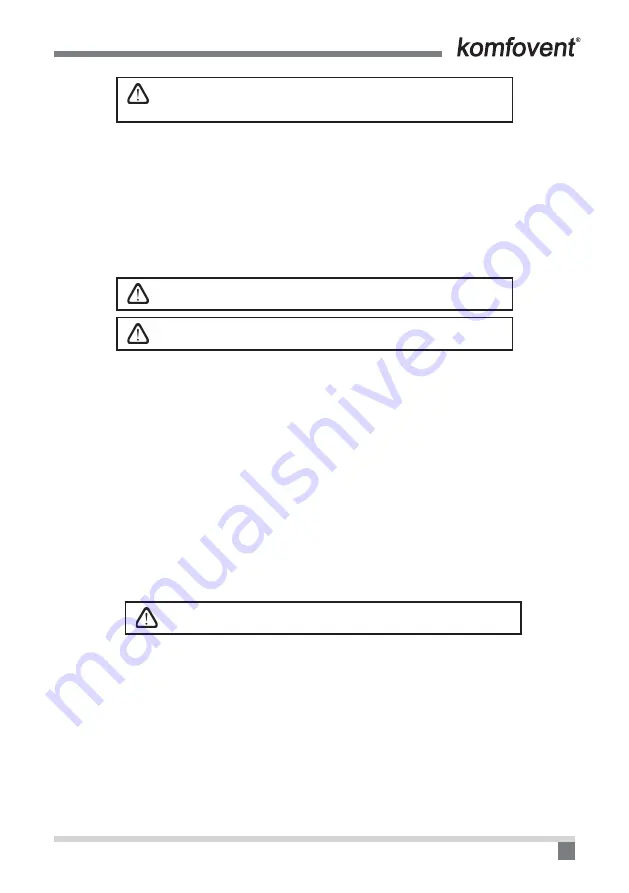
UAB AMALVA we reserve the right to make changes without prior notice.
35
It is important to maintain air heaters and coolers cleanliness; that is to
change filters installed in the air handling unit on time. If the air heater or
cooler gets dirty, to perform periodical cleaning.
Ductwork
The air flows in/out air handling unit through ductwork. We recommend using galvanized steel (Zn 275 gr/m
2
)
ductwork, to ensure easy cleaning and durability. It is necessary to use the ductwork system with low air flow rate
and small pressure drop to have necessary air volume and low sound level and save the energy. The appropriate
sound attenuators will reduce the noise level of the fans in the premises.
All ductwork should be insulated with 50–100 mm thickness insulation to avoid the condensation.
Note:
temperature sensor B1 has to be mounted in the supply air duct under electric heater (see the functional diagram
in Control System Electrical Installation and Operation Manual). It is necessary to leave space in straight air duct for
sensor mounting and guarantee the space for maintenance and service work. Minimal space between the unit and B1
sensor is the space of double air duct diameter.
Ductwork, steelwork and any other services should not be supported off
the unit.
In duct system, for units with electric air heater, use air closing damper
without spring return mechanism.
FINAL INSPECTION
After installation of the unit, a thorough inspection should be carried out. This should include inspecting the inside
of the unit and removing debris and tools, which may have been left behind by on site contractors. Replace any
panels, which may have been removed and close all access doors, ensuring that the door sealing gaskets have
not been damaged.
4. MAINTENANCE
It is recommended to carry out routine maintenance of the air handling unit REGO, 3–4 times per year.
REGO 1200P use the key to open the door. Do not release the door to swing freely, but open it slowly at a 90 de-
gree angle. Be careful while opening, because clogged filters might fall out.
Besides preventive maintenance inspection, the following operations should be performed:
1. Rotary heat exchanger check.
Inspection of the rotary heat exchanger is performed once per year. Free ro-
tation of the rotary heat exchanger, continuity of the rotating belt, absence of damages of the rotor drums
and the seal gasket are checked. It is necessary to check the stretch of belt. Free belt will slide and the
efficiency of rotary heat exchanger will fall down. To reach maximal efficiency, rotor must turn at least 8 times per
minute. Polluted heat exchanger will decrease efficiency. Clean heat exchanger with an air blast or wash with tepid
water. Check out water falling on the electric motor.
2. Fans check (once per year).
Polluted fans decrease efficiency.
Before performing any inspection work, check whether the unit is switched
off from the electric power supply.
Fans should be carefully cleaned with textile or soft brush. Do not use water. Do not break balance. Check if
direction of fan turns is right, because wrong direction of turns gives only 30% rating. Check if fan freely rotates
and is not mechanically damaged, if impeller does not touch suction nozzles, fan does not spread noise, the
pressure tubes are connected to the nozzle (if it is required), mounting bolts are screwed.
The rubber couplings connecting the motor base and the unit should be visually inspected for signs of wear and
replaced as necessary.
Any unusual noise or vibration when the fan is running should be immediately investigated, as this usually an
indication of wear or imbalance in the fan system.
3. Air heater check.
Recommended to perform periodical inspection and cleaning of heater. Check the plates of
water air heater. The air heater is cleaned with hoover from supply air side or with air blast from exhaust air side. If
it is very dirty, wash with tepid water, which will not make corrosion of aluminium. Check if position of return water
temperature sensor is right. Check if electric air heater is properly fixed, wires connections are not damaged and
heating elements are not bent. They can be damaged or bent due to uneven heat or uneven and turbulent air direc-
tion. Check if electric air heater is clear of unnecessary things and heating elements are not clogged, because this











































